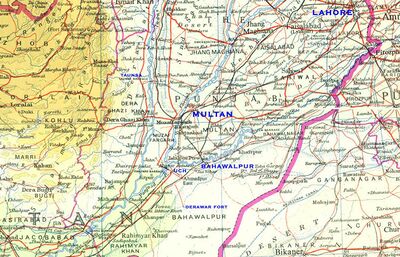Kot Kamalia
Kot Kamalia or Kamalia (Punjabi, Urdu:کمالیہ) is a city in the Toba Tek Singh District of the Punjab province of Pakistan.
Jat clans
History
In the 4th century, the ruler of this region was Raja Surcup, who had managed a boundary wall around his city. This fort was well known after the name of Raja Sarcup, a cruel and cunning ruler. Later the founded city was named after Kharal chief, Khan Kamal Khan Kharal, in the 14th Century and was, historically, known as "Kot Kamalia".
Kamalia was historically part of the erstwhile district and tehsil of Montgomery (Sahiwal), Punjab. According to Cunningham, it was one of the towns taken by Alexander the Great in 325 BC.[1]
Alexander Cunningham on Kot Kamalia
Alexander Cunningham [2] writes about Kot Kamalia:
[p.208]: Kot Kamalia is a small but ancient town situated on an isolated mound on the right or northern bank of the Ravi, which marks the extreme limit of the river's fluctuations on that side.1 It is 44 miles to the south-east of the junction of the Hydaspes and Akesines, and 35 miles to the east-south-east of Shorkot. It possesses an ancient mound of burnt-brick ruins, and is said to have been overthrown by a king from the West at the same time as Shorkot and Harapa.
Its present name, according to some people, was derived from a Muhammadan governor, named Kamal-ud-din. But this is not certain ; and I think it is quite possible that it may owe its origin to the Malli tribe, which still exists in this part of the country ; but whether the name be old or not, it is quite certain that the site is very ancient ; and I am, therefore, led to believe that it may be identified with the first city captured by Alexander in his campaign against the Malli.
Arrian's account of the capture is so clear and concise that I will quote it in his own words.2
On leaving the junction of the rivers Alexander " marched through a desert country against the Malli, and the first day pitched his tents on the banks of a small rivulet, about one hundred stadia distant from the river Akesines. Having there allowed his troops a little time for refreshment and rest, he ordered every one to fill all his vessels with water, which done, he continued his march the remaining part of that day and all night, and early the next morning arrived at
1 See Maps Nos. V. and VI.
2 ' Anabasis,' vi. 7.
[p.209]:
a city, whither many of the Malli had fled for refuge, and this was about 400 stadia distant from the Akesines."
The small rivulet here mentioned I believe to be the lower course of the Ayek river, which rises in the outer range of hills, and flows past Syalkot towards Sangala, below which the bed is still traceable for some distance. It appears again 18 miles to the east of Jhang, and is finally lost about 12 miles to the east of Shorkot.1 Now somewhere between these two points Alexander must have crossed the Ayek, as the desert country, which he afterwards traversed, lies immediately beyond it. If he had marched to the south he would have arrived at Shorkot, but he would not have encountered any desert, as his route would have been over the Khadar, or low-lying lands in the valley of the Chenab. A march of 46 miles in a southerly direction would have carried him also right up to the bank of the Hydraotes, or Ravi, a point which Alexander only reached, according to Arrian's narrative, after another night's march.2 As this march lasted from the first watch of the night until daylight, it cannot have been less than 18 or 20 miles, which agrees exactly with the distance of the Ravi opposite Tulamba from Kot Kamalia. The direction of Alexander's march must, therefore, have been to the south-east ; first to the Ayek river, where he halted to refresh his soldiers, and to fill their water vessels, and thence across the hard clayey and waterless tract called Sandar-Bar, that is, the 'Bār, a desert of the Sandar, or Chandra river. Thus the position of the rivulet, the description of the desolate country, and the distance of the city from the confluence of the rivers, all agree in
1 See Maps Nos. V. and VI.
2 'Anabasis,' vi. 7.
[p.210]: fixing the site of the fortress assaulted by Alexander with Kot Kamalia.
Arrian describes the place as a walled city with a castle seated on an eminence of difficult access, which the Indians held for a long time. At last it was carried by storm, and the whole of the garrison, to the number of 2000, were put to the sword.
Notable people
- Rana Muhammad Akram Khan, Ex-Chairman Punjab Bar Council.
- Mian Fareed Abbas Kathia, Politician and Local Land Lord
